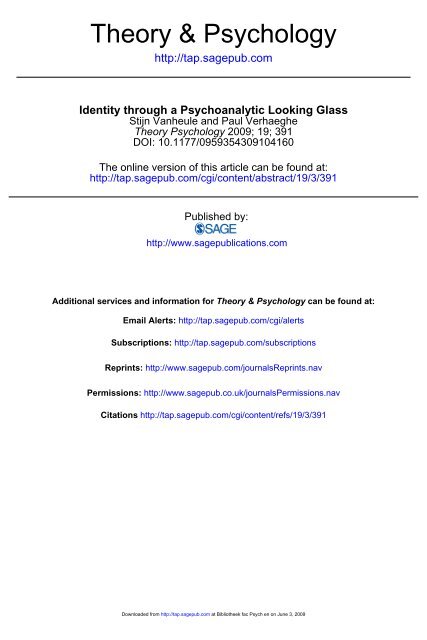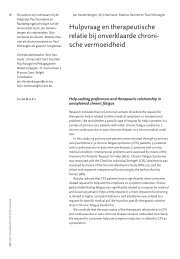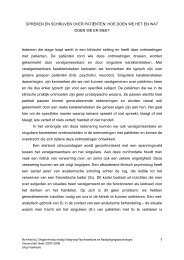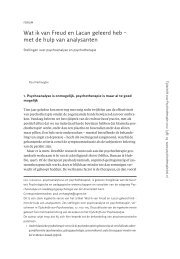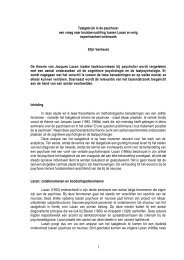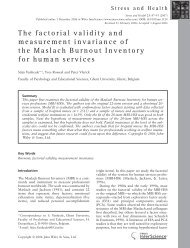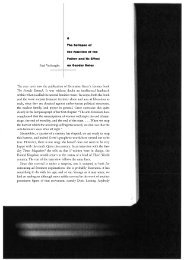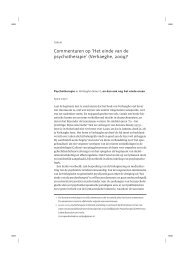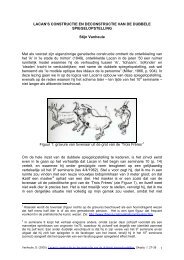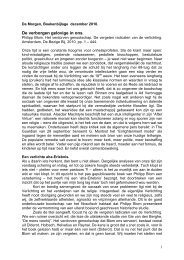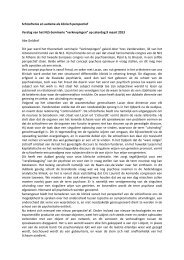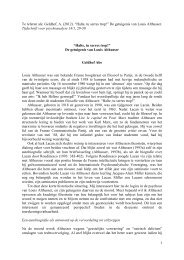Theory & Psychology
Theory & Psychology
Theory & Psychology
You also want an ePaper? Increase the reach of your titles
YUMPU automatically turns print PDFs into web optimized ePapers that Google loves.
<strong>Theory</strong> & <strong>Psychology</strong>http://tap.sagepub.comIdentity through a Psychoanalytic Looking GlassStijn Vanheule and Paul Verhaeghe<strong>Theory</strong> <strong>Psychology</strong> 2009; 19; 391DOI: 10.1177/0959354309104160The online version of this article can be found at:http://tap.sagepub.com/cgi/content/abstract/19/3/391Published by:http://www.sagepublications.comAdditional services and information for <strong>Theory</strong> & <strong>Psychology</strong> can be found at:Email Alerts: http://tap.sagepub.com/cgi/alertsSubscriptions: http://tap.sagepub.com/subscriptionsReprints: http://www.sagepub.com/journalsReprints.navPermissions: http://www.sagepub.co.uk/journalsPermissions.navCitations http://tap.sagepub.com/cgi/content/refs/19/3/391Downloaded from http://tap.sagepub.com at Bibliotheek fac Psych en on June 3, 2009
Identity through a PsychoanalyticLooking GlassStijn Vanheule & Paul VerhaegheGHENT UNIVERSITYABSTRACT. This paper examines how “identity” can be conceptualized andhow the experience of “oneself” is influenced by the interplay of forces insidethe mind and the body. We address three psychoanalytic approaches: Freud’stopological views on the mental apparatus; Lacan’s theory on the mirror stage,his optical model of the ideals of the subject, and his theory on the object a;and the theory of Fonagy and colleagues on how the self develops and howaffect regulation takes place in the context of attachment relationships. Weoutline similarities and differences in how identity is conceptualized withinthese perspectives and we discuss clinical implications.KEY WORDS: attachment, Freud, Lacan, identity, psychoanalysisThe notion of “identity” is not only a commonsensical term used to reflect selfunderstandingand experiences of collective belonging, but also a term that isfrequently used in the social sciences and in the humanities. The ongoing discussionabout whether or not it is a useful or interesting concept tends to functionon a fundamental assumption that identity implies a categorical membershipof a group. Such group membership includes gender, ethnicity, age, conviction,and life-style. Existing discussions on identity characteristically revolve aroundthe social, political and power dynamics connected with category membership,and around the individual’s subjective experience of identity in terms of affinity,conflict, or disturbance (e.g., Alcoff, 2006; Andacht & Michel, 2005; Connell,2006; Jansz & Timmers, 2002; Kernberg, 2006).From our perspective, one of the effects of such category-based thinking aboutidentity is its normative reasoning: by selecting certain qualities within categories,they function as norms. People compare themselves and others to thosenorms and end up with a state of conviction, or doubt, about whether or not theycorrespond to them. This is expressed in typical questions, such as am I masculineenough to be a real man? Is my child displaying age-appropriate behavior?THEORY & PSYCHOLOGY VOL. 19 (3): 391–411© The Author(s), 2009. Reprints and permissions: http://www.sagepub.co.uk/journalsPermissions.navDOI: 10.1177/0959354309104160 http://tap.sagepub.comDownloaded from http://tap.sagepub.com at Bibliotheek fac Psych en on June 3, 2009
392 THEORY & PSYCHOLOGY 19(3)In this paper we explore a non-categorical approach to identity. Our point ofdeparture is the idea that a category-based approach to identity neglects a numberof questions that we regard as crucial. When considering the work of thepsychoanalyst Jacques Lacan, the question of identity is approached from alogical point of view. Particularly in his seminar on Identification (Lacan,1961–1962), Lacan indicates that identity can be defined as an entity that isequal to itself (i.e., A = A). Punning on this logical formula, he asks how itcomes about that someone can start experiencing one as “one-self”: how doesit happen that I consider the idea of a “me” as part of my own self? And whyin fact do we say “my-self”? Is it not self-evident that this “my” is a part of the“self”? And isn’t it curious that the word “self,” which we use to make autoreferences,is in many languages also used to refer to sameness? Along theselines, Lacan indicates that the experience of identity is a result of the mechanismof “identification,” which functions as an answer to a question that lies atthe basis of subjectivity: “Who am I?” In saying and believing that “I am me”and that “I” mirrors “myself,” people produce answers to this question.In what follows, we discuss these questions further and examine how thesubjective experience of one as oneself can be thought of. We highlight how thisexperience is influenced by the interplay with other forces inside the mind andthe body. We will attempt an understanding of how the subjective experience ofidentity comes about, and how it is limited by other subjective experiences.We do so by exploring differences and similarities in three psychoanalyticapproaches—Freudian, Lacanian, and psychoanalytic attachment theory withinthe tradition of Fonagy and Target. We discuss Freud’s topological views on themental apparatus; Lacan’s theory on the mirror stage, his optical model of theideals of the subject, and his theory on the object a; and Fonagy and colleagues’theory on how the self develops and how affect regulation takes place in thecontext of attachment relationships. We also discuss what these theories implyin conceptualizing the aim of psychoanalysis as a clinical praxis.In contrast to a number of other psychoanalytic schools (see Abend, 1974;Kernberg, 2006) and the contemporary category-based approach, identity isnot a core concept in the psychoanalytic perspectives we study. We neverthelesschose these perspectives deliberately as all three present clear ideas onhow the experience of one as oneself can be thought of. They also illustratehow the comprehensiveness of this experience is limited by forces that cannotbe thought of as parts of oneself. Through these perspectives, we aim at understandingidentity in a non-normative and process-like direction. We have chosenFreud because we think that his theory on the development of the Ego isfar too neglected today. Through the multiple interpretations of his work, theinnovative character of his ideas has become diluted. We have chosen Lacanbecause of the combination of his “return to Freud” and his own theory onidentification and on the becoming of a subject, which have made certainimplications of Freud’s theory far more obvious. Finally, we have chosen psychoanalyticattachment theory for its novel approach to classic psychoanalyticDownloaded from http://tap.sagepub.com at Bibliotheek fac Psych en on June 3, 2009
VANHEULE & VERHAEGHE: IDENTITY THROUGH A PSYCHOANALYTIC LOOKING GLASS 393questions—we concentrate on the ideas with respect to the development of theself and the role of mirroring in this process—and for its ample connectionsto contemporary cognitive and developmental psychology. Obviously, otherchoices could be argued for, especially in the Anglo-Saxon tradition (Winnicottand object relations theory, Stern and infant research, Benjamin and intersubjectiveanalysis, Kohut and self-psychology). It is our familiarity with the perspectiveswe chose that guided us in selecting them. The option for addressingother perspectives remains open.A Freudian Perspective on the Question of IdentityTraditionally, Freud’s theory is studied in terms of his double topology, usuallyhighlighting the fact that his second topology turns the Ego into one of the threeconstituting elements of the psyche, along with the Id and the Super-Ego.At the time of his first topology—the Conscious, the Preconscious, and theUnconscious—the Ego is considered a general concept, almost synonymouswith identity or personality. From our point of view, such a reading is wrong, ifonly because it neglects what we consider to be the core problem for which bothtopologies try to produce an answer. Freud is preoccupied with this problemfrom the beginning: how can we understand the inner division in mental functioning?His early concepts of “Abwehr,” “antithetical ideas,” and “splitting” alltestify to his first attempt (Freud, 1894/1962a, 1896/1962b). In our reading, thisis the original starting point of psychoanalysis, and at the same time one of themost important divergences from mainstream academic psychology and its ideason an undivided personality. Moreover, the initial simple opposition between anoutside and an inside (conscious versus unconscious, Ego versus object, subjectversus other, self versus primary caregiver) is problematic right from the inceptionof psychoanalysis (Freud, 1925/1961b; Freud & Breuer, 1895/1955).Freud’s theory on the Ego is far from univocal. Developmentally, he describesit from both a phylogenetic and an ontogenetic perspective. Phylogenetically,it amounts to the development of an adaptive apparatus, with the focus on perceptionand consciousness (Pcpt.Cs) and the aim of survival. Ontogenetically,it is the product of successive identifications, resulting in the production of alove object for another agency (i.e., the Super-Ego). A topological, dynamic,and economic point of view is described within this ontogenetic perspective.Topologically, the Freudian Ego only has relative autonomy, as it has to meetthe requirements of the Id, the Super-Ego, and external reality. Dynamically,the Ego represents the defensive side of the neurotic conflict, as it is the seatof the defensive mechanisms and the signal anxiety (Freud & Breuer, 1895/1955,p. 116). Economically the Ego has to take care of the function of synthesis.This latter function is without doubt the most problematic one. In Freud’searly theories, the internal division already holds a central place, and asimple binary opposition is wrong. In his two seminal papers on “TheDownloaded from http://tap.sagepub.com at Bibliotheek fac Psych en on June 3, 2009
394 THEORY & PSYCHOLOGY 19(3)Neuro-psychoses of Defence” (Freud, 1894/1962a, 1896/1962b) and theStudies on Hysteria (Freud & Breuer, 1895/1955, p. 269) he puts forth theidea that the cause of psychopathology is the fact that certain representationsare incompatible with the dominating (i.e., the accepted) part of the Ego,and that the former are therefore repulsed by this dominating Ego part. Theresult is that the warded-off part operates in a pathogenic way. Nevertheless,Freud has to admit even at this early stage of his theory that the representationalgroup that has been warded off by the Ego remains part of this Ego,however “incompatible” it might be (Freud & Breuer, 1895/1955, p. 290).Obviously, there is no black-and-white division and the split is internal tothe Ego itself.Here we meet three basic characteristics of human identity right from thestart of psychoanalytic theory: the Ego is constituted by representations thatcontain an internal division caused by a defensive process that is installedby the Ego itself. 1 This division will be elaborated in terms of conscious andunconscious, albeit with the same problem. Conscious and unconscious arenot mutually exclusive terms; on the contrary, they present a dynamicmixture. Freud tries to understand this in one of his most important metapsychologicalstudies, A Project for a Scientific <strong>Psychology</strong> (Freud, 1950/1966). 2 In this book-length work he describes the Ego as an organization ofassociatively linked representations that are invested with endogenous energy,whose function is to inhibit primary processes in order to avoid the productionof unpleasure. The further elaboration of his theory mainly presents thedevelopmental history of this Ego. In this respect, the obvious questions are:Where do these representations come from? What is the cause of this everpresentdivision and of this necessity for a defense? In the meantime, it isclear that Freud’s implicit assumption is that there is no such thing as an a prioriidentity: the Ego is constructed via an interactive process. Three of Freud’spapers are seminal in this respect, with narcissism, melancholia, and, finally,the Ego as central themes (Freud, 1914/1957a, 1917/1957d, 1923/1961a).In his paper on narcissism, Freud writes explicitly that the Ego is not presentfrom birth, in contrast to the auto-erotic drives (Freud, 1914/1957a, p. 77).Originally, the infant is preoccupied with the satisfaction of the latter, simplyin order to survive. Therefore, the child needs the other—basically themother—resulting in what Freud calls the “Anlehnung” (attachment). This isa double process: the sexual drives are grafted upon the self-preservative vitalfunctions and the mother becomes the first sexual object (Freud, 1914/1957a,pp. 87–88). 3 Primary narcissism is then replaced by the installation of a divisionbetween the actual Ego and the Ego-Ideal. Freud hypothesizes the existenceof yet another psychical construct whose function it is to constantlymeasure the distance between the actual and the Ideal Ego (Freud,1914/1957a, pp. 93–96). He repeats this idea in “Mourning and Melancholia”(Freud, 1917/1957d, p. 247), and refers to it in “The Ego and the Id” as theSuper-Ego (1923/1961a, p. 28). Both of them (Super-Ego and Ideal-Ego) goDownloaded from http://tap.sagepub.com at Bibliotheek fac Psych en on June 3, 2009
VANHEULE & VERHAEGHE: IDENTITY THROUGH A PSYCHOANALYTIC LOOKING GLASS 395back to the original critical voice of the parents, later complemented byimportant others and public opinion (Freud, 1914/1957a, p. 96). 4 Freudunderstands the development of the Ego as a never-ending attempt to returnto the state of primary narcissism, albeit via the ideal criteria as put forwardby other(s) (1914/1957a, p. 100).Notice that his theory puts the origin of the Ego (both the actual and theIdeal) in the other. This idea is implicit in Freud’s “Mourning and Melancholia,”particularly where he situates the origin of the Ego in identificatory processes.The central thesis of this paper is well known: in certain cases of depression,there is a regression from object choice to identification with the lost object,which changes the Ego (Freud, 1917/1957d, p. 249). At this point, we have tointroduce the difference between a primary identification and subsequent secondaryones. In Freud’s developmental reasoning, there is a primary identificationthat is “the earliest and original form of emotional tie” (Freud,1921/1955b, p. 107) that is indistinguishable from object choice (Freud,1923/1961a, p. 29). The first description he produces in this respect concernsthe identification of the son with the father (Freud, 1921/1955b, p. 105), buthe adds later, in a footnote, that it would be safer to talk about an identificationof the child “with the parents,” as the child at this early stage is not ableto make a distinction between the mother and the father (Freud, 1923/1961a,p. 31, n. 1). From this perspective, the Ego starts with an original identificationand is subsequently enlarged by successive identificatory layers, eachone going back to a specific object relation. In “The Ego and the Id” Freudstates that these layers are the basis of one’s character (Freud, 1923/1961a,pp. 28–29). Moreover, in that same paper he returns to his original idea aboutthe inner division of the Ego, explaining this split by the contradictionsbetween the different (secondary) identifications that constitute it (Freud,1923/1961a, pp. 30–31).In our reading, the latter paper is especially important because of Freud’selaborations of his idea that the Ego is constructed through representations.Here he addresses the subject of consciousness. His starting question is therelation between what he calls the “internal perceptions,” arising from the Id,on the one hand, and the Ego and the process of something becoming conscious,on the other (Freud, 1923/1961a, p. 21). His answer is quite clear: itis the connection of these internal processes to verbal representations that transformsthese processes into conscious perceptions, making their actual perceptionpossible “as if they came from without” (Freud, 1923/1961a, p. 23). 5The Ego is precisely the construct that is based upon these perceptions, on topof the Id, via the connection to verbal representations and the direct influenceof the external world. In Freud’s perspective, the function of the Ego is to passon the external requirements to the Id. In his new terminology, the Id is thedrive source, whereas the Ego is that part of the Id that is changed because ofand through the direct influence of the external world through the Perception-Consciousness (Pcpt.Cs) system (Freud, 1923/1961a, p. 25).Downloaded from http://tap.sagepub.com at Bibliotheek fac Psych en on June 3, 2009
396 THEORY & PSYCHOLOGY 19(3)A Lacanian Perspective on the Question of IdentityLacan’s conception of human subjectivity can best be understood within thecontext of Freud’s (1914/1957a, p. 77) claim in “On Narcissism” that onlyauto-erotic drives are there from the very first, and that the Ego comes intoexistence as the result of later development. Lacan clearly endorsed this thesis,and a consequent major theme that runs through his work is how this developmentcan best be understood (see also Malone, 2000).A first and best-known elaboration is given in his papers on the mirror stage(Lacan, 1953, 1949/2006a), and in his first seminars (1978/1988a, 1978/1988b).In line with insights from ethology on how animal development is triggered andshaped by the “Gestalts” animals are confronted with, Lacan stresses thatimages guide human development as well. In this context, the basic problem heattributes to the infant is its organic disturbance and discord, which are an effectof the infant’s lack of sensory and motor coordination. This results in a fragmentedexperience of the body. Add to this the thrust that libidinal drives implyand we have a perfect cocktail for a generalized state of malaise and helplessness(see also Lacan, 2004, pp. 75, 162). In Lacan’s interpretation the Egocomes into being as a reaction against this troubling state. Based on mirroring(i.e., qualifying images, be they self-images or images of others as mirrorimages), a subject identifies with a body image and regards this image as itsown. Thus considered, the primitive Ego in essence corresponds to the bodyimage that offers the infant an opportunity to see itself as a unity, and thus toachieve self-mastery. 6 This is the psychic function Lacan attributes to the Egoin his first elaborations: it is an instance that offers a feeling of unity and thatenables humans to anticipate a state of subjective completion. The drawback helinks to assuming an Ego by mirroring with an Ideal Ego is that this deludes thehuman subject: the feeling of unity the Ego provides is an illusion that blindsus to everything that does not fit the image. Phrased differently, this firstmirror-stage logic states that the development of the Ego, and more broadly thepossibility of experiencing one as identical to oneself, arises against a backgroundof chaos in the infant, caused by somatic immaturity and the claims ofthe drive. In the Lacanian logic, the answer presented by the other during themirror stage, “Thou art that,” evokes retroactively the question “Who am I?”(Lacan, 1949/2006a, p. 81). Mirroring is the process that calls the Ego into existenceand comes down to the adoption of a body image that was first activelycaptured by the subject in the external world as something ideal—as an IdealEgo. It is only to the extent that the alien image has a value in integrating innerchaos that a subject discerns this image as something ideal with which it isfavorable to identify. Although Lacan describes the process of mirroring as anecessary stage in human development, he also strongly emphasizes that itimplies a more generalized deluded stance vis-à-vis reality, others, and one’sown drive. It results in “mihilism”: the violent tendency to consider everythingfrom the perspective of me (Lacan, 1961–1962, lesson November 15, 1961).Downloaded from http://tap.sagepub.com at Bibliotheek fac Psych en on June 3, 2009
VANHEULE & VERHAEGHE: IDENTITY THROUGH A PSYCHOANALYTIC LOOKING GLASS 397Later in his thinking, as he elaborates his concept “object a,” Lacan discountsthe adequacy of this first answer to the problem of how the experience of identitydevelops. We will discuss the idea that precisely at the level of his basicassumption (i.e., mastery of corporeal processes through the development of amental image of the body), Lacan grew increasingly critical.However, in a second and intermediate stage of his thinking, Lacan stillclung to the idea that by mirroring elements from the outside world, the Egoand the experience of one’s own identity develop. He still conceptualizes themirror process as an activity the subject actively engages in, but the problemthat it apparently functions to answer and the modalities through which ittakes place are framed differently. This intermediate conceptualization can befound in the works that deal with the “schema of the two mirrors” (Lacan,1978/1988a, 1978/1988b, 2004, 1960/2006c). The problem now postulated atthe basis of Ego development and of one’s experience of identity is located atthe level of desire. 7 Lacan starts from the axiom that the other’s desire isessentially enigmatic to a subject. It comes across as a threatening riddle. Heassumes that in their contact with others, human subjects invariably, but notnecessarily consciously, ask themselves the question: “What does she/he wantfrom me?” The fact that no ready-made answers for this question exist disturbsthe subject and indeed evokes anxiety, yet also constitutes a challengefor human development. Lacan considers the creation of Ego-Ideals as thepreeminent solution we all construct to solve this basic problem. Answeringthe question “Who am I?” thus functions as a response to the problem of whatthe other intends in relation to me. By molding one’s own Ego, and by observingthe way the other reacts to it, a subject tries to see which object it is inrelation to the other’s desire, and tries to make sure that the other desires thecontent one tries to be identical with.Within this two-mirror logic, the development of an Ego goes beyond thecreation of a self-image in relation to perceived other images; it exceeds theprocess of bringing the Ego to perfection by continuously tuning it into IdealEgos mirrored from the outer world. Directly in line with his development ofa theory on the role of the signifier in mental functioning, Lacan claims thatthe process of identification is symbolically mediated: symbolic elementsdetermine the adoption of self-images. The symbolic elements that fulfill thisfunction are the Ego-Ideals. In Lacan’s interpretation, Ego-Ideals are symbolicelements that a subject takes from the discourse of the other. 8 Thismeans that they are nothing but privileged discursive elements: specific traitsand characteristics of others that arrest a subject’s attention, and are unconsciouslyadopted to the extent that they are considered to imply an answer tothe riddle of the other’s desire. We can illustrate this seemingly complex ideaby referring to the basic development of a child. For example, it is likely thata little boy will identify with specific characteristics of his father or grandfatherto the extent that these characteristics don’t leave his beloved motherunaffected. Traits which, in the boy’s interpretation, are thought to organizeDownloaded from http://tap.sagepub.com at Bibliotheek fac Psych en on June 3, 2009
398 THEORY & PSYCHOLOGY 19(3)the mother’s desire will most probably crystallize in his identifications. In thisprocess, the Ego-Ideals fulfill a double aim. They are the supports by meansof which a subject can obtain an idea of who she/he is, and of who she/hewants to be. In line with the enigma of the other’s desire, they also functionto obtain recognition. Within this line of thinking, knowledge of what theother desires and likes in me works as an anxiolytic agent: if one feels confidentthat the other’s desire is organized by specific characteristics of oneself,this desire loses its threatening qualities. Lacan (1973/1998, p. 257) says thatthrough identification with Ego-Ideals a subject feels “both satisfactory andloved” in relation to others. This is one of the reasons Lacan (1958/2006b)claims that man’s desire is the other’s desire. Certainty of the fact that one isdesired by the other introduces organization into this relationship.Typical of this second, double-mirror logic with respect to the developmentof the Ego and the experience of one’s own identity (“I am what I am”) is thatthese are no longer understood solely as a cherished solution for inner chaos,but more significantly as the landmarks by means of which a subject orientsitself in the domain of the other’s peculiar desire. However, later in his thinkingLacan again leaves this line of reasoning behind. Starting with his 10thseminar (Lacan, 2004), he gradually concludes that the essence of humansubjectivity is something other than what he has attempted to describe thusfar. In this seminar he deconstructs his own schema of the two mirrors andindicates a new problem that can no longer be thought of within this logic. Heconcludes that the most essential dimension of subjectivity cannot be understoodwithin a symmetric logic of mirroring, and he gradually loses interestin mirror processes.The issue he stresses in this new, third logic is that the effect of mirroring isonly partial. Although it is true that through mirroring the libidinal drivesobtain a degree of organization in the body image and in relationship structures,an important aspect of the drive remains untamed and untamable bymeans of images and signifiers. The concept Lacan invents for this “real” ornon-representable remainder of the libidinal drive is the “object a.” From nowon this concept becomes the central construct around which he organizes histhinking on the nature of subjectivity (see Lacan, 1973/1998). He defines theobject a as one that cannot be mirrored or represented; it does not have animage as its counterpart. It is a fleshly urge, an auto-erotic residue of the drivethat cannot be thought in relation to a classic psychoanalytic object. “The[object] a is what remains irreducible in the advent of the subject at the locusof the other, and it is from this that it is going to take on its function” (Lacan,2004, p. 189). Characteristic of the object a is that it produces a breach in theexperience of our identity; essential aspects of our being, having to do with thedrive, are at odds with the mental representations we construct of ourselves. Anexample he gives to illustrate this dimension is the subsidence of the male sexualorgan after an orgasm. Man’s powerlessness in relation to this subsidenceshows how the body remains obstinate in relation to a subject’s intentions.Downloaded from http://tap.sagepub.com at Bibliotheek fac Psych en on June 3, 2009
VANHEULE & VERHAEGHE: IDENTITY THROUGH A PSYCHOANALYTIC LOOKING GLASS 399Within this new logic, concepts like identity, Ego, or personality becomehighly problematic as they only reflect the organized or mirrored side of subjectivity,that side organized by the imaginary and the symbolic registers. InLacan’s interpretation these dimensions obfuscate the real of the object a.Furthermore, they constitute a defense against it. The net result of the third shiftin Lacan’s thinking is that he now conceptualizes subjectivity as essentiallydivided. From his 11th seminar onward (Lacan, 1973/1998), he combines hisprevious theories with the concept of the divided subject (Verhaeghe, 1998).The human experience of identity is constructed via identification with the signifiersof the desire of the other. In order to stress the impact of the other on theexperience of identity, Lacan refers to this process as alienation. As these signifierspresent conflicting desires, the subject is essentially divided between andthrough them. Nevertheless, this alienation is never a total one because the signifiersof the desire of the other can never represent the real of the object a,meaning that there is a structural lack in the chain of signifiers. This opens thepossibility of separation for the subject. At the same time, this lack indicates aneven more essential division: that between the signified part of the subject andthe real of the drive. The conflicting relation between the real, on the one hand,and the symbolic and imaginary elements of subjectivity, on the other, is astructural characteristic of the human being; it is unbridgeable by any efforts.An Attachment Perspective on the Question of IdentityPsychoanalytic attachment theory within the tradition of Fonagy and Target(Fonagy & Target, 1996, 2000, 2007; Target & Fonagy, 1996) is the most recentconceptualization of how people’s experience of identity comes about. Asexplained in our introduction, we chose this approach because it permitsbridges to cognitive and developmental psychology. The Freudian Ego and theLacanian divided subject meet here with the idea of the “self.” In this theory,the focus is explicitly on the combination of self-development and affect regulation.In spite of the different denomination—affect and embodiment—theirstarting point is very close to Freud’s (1915/1957b): “somatic processes, occurringin an organ or part of the body” (p. 123; Fonagy, Gergely, Jurist, & Target,2002, pp. 82–96). For Freud (1915/1957b), these processes are “sources of thedrive,” the drive being defined as “a measure of the demand made upon themind for work in consequence of its connection with the body” (pp. 122–123).We should not forget that in Freud’s theory the drives are attached to “selfpreservative”Ego-drives. The German word “Anlehnung” is semantically closeto the English “attachment,” which was unfortunately distorted by the Englishtranslation into the neologistic “anaclitic” (Freud, 1914/1957a, pp. 87–90).In psychoanalytic attachment theory, a description of the development of selfexperienceis presented in an empirical tradition and can, as stated above, be consideredan endorsing expansion of what Freud postulates in “The Ego and the Id.”Downloaded from http://tap.sagepub.com at Bibliotheek fac Psych en on June 3, 2009
400 THEORY & PSYCHOLOGY 19(3)The Ego (“self”) is the product of the connection between the perceptions of whatis going on in the inside and the representations presented by the external world,the function being reality testing. The main difference is that Fonagy and colleagues(2002) “see the self as originally an extension of experience of the other”(p. 266), whereas Freud seems to take the opposite position.Based mainly on research from developmental psychology, Fonagy andcolleagues (2002) claim that intersubjectivity is not a priori present in theinfant. From birth onward, the child displays a clear tendency toward “contingencydetection and social biofeedback” (p. 221). The perception of theinternal states, in combination with the regulating mirroring of these states bythe primary caregiver, results in the construction of a representational systemthat is rooted in language (Fonagy et al., 2002; Fonagy & Target, 2007).Because of the specific nature of this mirroring—in normal circumstances acombination of caregiving and regulating—this representational constructionis not only self-development but also affect regulation.This empirical reasoning is based on the social biofeedback theory of parentalaffect-mirroring (Fonagy et al., 2002, pp. 145–203; Gergely & Watson, 1996).This theory explains how empathic affect-regulative mirroring interactions withinan attachment relation lead to the construction of second-order representations ofaffect states and to their adaptive use in affective self-regulation. At moments ofalarm (i.e., arousal), the infant performs attachment behavior such as proximityseekingand proximity-maintaining in an effort of self-preservation and protection.Social biofeedback theory postulates that the infant is instinctively driven toexpress dynamic changes in its internal affective states, whereas the caregiver isdriven to reflect the infant’s state-expressive behavior, albeit in a soothing andregulating way. Hereby functions “the mother’s empathic face as the signifier andhis [the infant’s] own emotional arousal as the signified” (Fonagy et al., 2002,p. 126). As a result, the infant becomes able to detect and group together the setsof internal state cues that are indicative of its categorically distinct dispositionalaffect states. Based on this reflective mirroring, the infant establishes secondaryrepresentations of its own primary affective states. The internalization of themirrored presentations associated with these primary unconscious affect statesprovides the infant with a sense of self as a self-regulating agent (Fonagy et al.,2002, p. 174). What thus takes place is a transition: the constitutional self (i.e.,“an individual’s biologically determined experiences associated with emotionalexpressivity as well as temperamental manifestations of affect”, p. 11), transformsinto a complex of self-representations. The underlying mechanism is theinnate sensitivity of the child in detecting contingencies between its automaticstate-expressive behavior and the affect-reflective facial and vocal displays of thecaregivers. In order to maximize this contingency, the child will reduce or refineits emotional expressions and by such means gain control over the other’s reaction.Moreover, at the very same time and through the very same process, thechild’s internal state improves in that the establishment of the self implies theestablishment of affect regulation as well.Downloaded from http://tap.sagepub.com at Bibliotheek fac Psych en on June 3, 2009
VANHEULE & VERHAEGHE: IDENTITY THROUGH A PSYCHOANALYTIC LOOKING GLASS 401The child’s secondary representations of its own affective states form thebasis for mentalization, that is, thinking about oneself and about the other(Fonagy et al., 2002, pp. 253–291). As a result of mental development duringthe first years of life, psychic reality is structured in two separate modes: theequivalence mode and the pretend mode. In the psychic equivalence mode, achild expects that its own and the other’s internal worlds correspond completelyto the external situation; there is no difference between representationand reality. In the pretend mode, ideas are felt to be only mental and the correspondenceto reality is absent. Whereas the equivalence mode of functioningpermits the establishment of a firm sense of self, the pretend mode permits asafe exploration, a “playing with reality” in which there is no consideration ofthe real consequences of this playing. 9 The integration between these twomodes depends largely on the quality of the mirroring provided by the caregivers.The mirroring has to be congruent with, but certainly not identical to,the emotional state of the child. It is the receipt of one’s own experience backin a modulated form that makes it manageable. In this regard, Fonagy andTarget (1996, 2000) emphasize the importance of communicating a contrastingaffect. On the other hand, it is important for the child to realize that thereaction of the other is not real, but merely a reflection of the child’s innerstate. This occurs through “marking,” an exaggerated parental imitation of thechild’s experienced emotions (Fonagy et al., 2002, p. 177). The anchoring ofthe latter to its own state finally results in the child’s construction of a separate,second-order representation of the primary affect experience, which hasthe effect of making it manageable. The integration of both modes, at the timeof the oedipal conflict, leads to the establishment of a “truly representationalorder,” that is, a reflective or mentalizing mode (Fonagy et al., 2002, p. 267).Summarizing, it can be said that the self is mainly the product of the other’sbehavior in the interaction (Fonagy et al., 2002, p. 135), which is apparent inthe case of deviant mirroring styles which can result in pathological identitydevelopment, characterized by the idea of the “alien self.” The latter is theinternalization of a misattuned mirroring. Although to a certain extent presentin every one of us, it is normally neutralized through what is called “narrativesmoothing of the basic gaps in the self-structure” (Fonagy et al., 2002, p. 13;see also pp. 130, 198). In case of a pathological mirroring, the gap betweenthe alien self and what is called the “constitutional,” “bodily,” “physical,”“core,” or “true” self is unbridgeable, and the typical results are projectiveidentification and splitting. In matters of the development of the experienceof identity, this means that the child does not gain access to its constitutionalself-states and that it will not be able to think about its real thoughts andwishes (Fonagy et al., 2002, p. 15). Moreover, the child will not be able toread correctly the mental states of the other, meaning that the function ofmentalization is impaired in both directions. More specifically, a congruentbut unmarked parental mirroring in infancy is important in the developmentof borderline personality disorder, whereas an incongruent mirroring lies atDownloaded from http://tap.sagepub.com at Bibliotheek fac Psych en on June 3, 2009
402 THEORY & PSYCHOLOGY 19(3)the base of narcissistic personality disorder (Bateman & Fonagy, 2004, p. 83).The therapeutic goal is to create a working alliance by which the patient gainsaccess to his or her own mental states.DiscussionIn this paper we have explored the questions of how the subjective experience ofone as “one-self” can be thought of, and how this experience is influenced by theinterplay with other forces inside the mind and the body. We have explored thesethrough Freudian and Lacanian psychoanalysis and psychoanalytic attachmenttheory. Current thinking about identity strongly turns around categorical membershipto groups; people judge themselves and others based on qualities impliedin identity categories, resulting in a number of social and subjective effects, ofwhich normative thinking is an important one. We have aimed at a re-conceptualizationof the notion of identity in a non-normative and process-like direction.As a result, we believe that at least three common themes can be put forwardwhich, in the different psychoanalytic traditions we have examined, obtain specificinterpretations. Each theme has a number of clinical implications as well.As we will indicate, in our reading the differences among these three approacheshave more often than not to do with a different focus in their conceptualization.Nevertheless, in matters of clinical praxis, differences are more substantial.A first common theme we detect is that the experience of identity is notinnate, but rather a construct that comes into being in relation to the other. Assuch the three approaches are all in line with the etymological meaning of theLatin “identitas”: we become ourselves based on similarity and resemblance.Each theory elaborates this idea with its own focus. It is least present in theFreudian line of thinking, which accentuates the development of the drives inthe child. Freud does indicate that self-representations are adopted within thecontext of object relations, a theme that is later elaborated in the Lacanianmodel and in contemporary psychoanalytic attachment theory. Lacan qualifieshumans as agents who actively identify with elements from others by consideringothers as mirrors of themselves. Consequently, the experience of subjectiveidentity is fundamentally alienated, inevitably constituted by alien elementsderived from the other. Psychoanalytic attachment theory emphasizes the activerole of the other in the development of the experience of identity. The other mirrorsthe child’s constitutional states, and the child develops secondary representationson its own as a self. In contrast to Lacan, Fonagy and his associatesaccentuate the fact that mirroring can be both adequate and inadequate, respectively,resulting in adequate self-representations or in alien self-states.A first clinical implication of this theme concerns Freud’s ideas with respectto the so-called “choice of neurosis,” the way in which someone contributes tohis or her own development of pathology. We think Freudian theory on thisissue is unclear. Lacanian and psychoanalytic attachment theory give an answerDownloaded from http://tap.sagepub.com at Bibliotheek fac Psych en on June 3, 2009
VANHEULE & VERHAEGHE: IDENTITY THROUGH A PSYCHOANALYTIC LOOKING GLASS 403that at first glance is quite different, even to the point of being opposite toFreud’s. Lacanian theory accentuates the agential qualities of the subject: howit actively adopts representations via the other and how it interprets the other’sdesire. Attachment theory focuses instead on the agential role of the other: howthe other mirrors the experiences of the infant. In a naïve reading, both theoriesattribute the main responsibility for the development of psychopathology to adifferent agency—either to the subject or to the other. However, we believe thatthe differences between both approaches are less radical than they might seemat first, and that the interaction between subject and other should not be underestimated.Given Lacan’s assumption that the experience of one as oneself isradically alienated and based on the other, it can only be composed of what theother has offered to a subject. As such it is no wonder that peculiarities in whatis offered by the other will be reflected in peculiarities at the level of the subjectiveidentity experience. In psychoanalytic attachment theory, reactions of achild are conceptualized as contributory in the creation of an environment. Inother words, a child shapes his/her environment as a reaction to the way inwhich it is shaped by the other, which also makes that interaction an importanttheme. The key to both theories is that subject and other, or child and caregivers,are not strictly separate entities, but rather dynamically intermixed.A second clinical implication is that psychopathology can be thought of bothin the context of an organized, complex self-experience that has been developedin relation to others and in which answers to the question of “who am I” havebeen acquired, and in the context of a loosely integrated self-experience that ischaracterized by a lack of established answers to the question of who one is aswell as by an obvious deficiency of other-based organization. The first possibilityconcerns neurotic pathology. In this case psychopathology is thought ofas a conflict within the experience of identity; it goes back to an unconsciousconflict based on incompatible parts of the Ego, grounded in incompatible identificationswith significant others concerning drive and desire.The following clinical vignette of Laura, a 40-year-old woman who was inpsychoanalytic treatment with the second author for three years, illustratesthis. Laura grew up in a family where her Don Juan-like father first called her“the princess,” and later regarded her as a sexually attractive woman, whilesimultaneously rejecting his wife, her mother, as a domestic drudge. As anadult, she identified with the position defined by her father, meaning that shebehaved like an adolescent at the age of 40. Superficially, Laura was happybut feelings of guilt toward her mother were always present, in combinationwith an underlying sense of dissatisfaction. When she became pregnant at arather late age, the division and the underlying conflict leapt massively intothe foreground. It was impossible for her to reconcile becoming a mother withthe dominating identification with the desire of the father. Nevertheless, shewas not consciously aware of this conflict and it was expressed in obsessionalsymptoms about the possible presence of germs in her house and an insistentanxiety about her inability to be a good mother.Downloaded from http://tap.sagepub.com at Bibliotheek fac Psych en on June 3, 2009
404 THEORY & PSYCHOLOGY 19(3)The other possibility we indicated concerns a case where the other hardlyfunctioned as a stable and stabilizing agency, as a result of which a chaoticself-experience is the problem rather than a conflict within the experience ofidentity. This situation is typical for borderline pathology, where the issue of“who one is” is not addressed through answers that divide mental life, but israther evoked through a series of brute enactments. The lack of subjectiveembeddedness is enacted in often destructive ways that jeopardize the subject’sexistence (as a living being, as a sexual being, as a parent, as a child …)(see Verhaeghe, 2004). An illustrative example of this type of pathology isgiven by Fonagy and colleagues (2002, pp. 388–410) in the case descriptionof Emma, a woman who entered psychoanalytic treatment at the Anna FreudCentre at the age of 19 and remained in therapy for six years. The patient wasreferred by a diabetologist because of her mismanagement of her diabetes,which frequently resulted in keto-acidosis. Without discussing the case indetail we first notice a lack of stability in the patient’s self-experience, whichis evident in the partial representation of her mental experience. Emma isfrightened of her own aggressive thoughts and she avoids mentalizing activitywith respect to these thoughts. Aggression is warded off in radical and dissociatingways (e.g., at one time during the treatment she shields her eyesfrom the head wound her therapist just sustained; later on it becomes clearthat the wound evoked her anxieties) and the effect is its reappearance inexternalized and split-off ways (e.g., in the gross diabetic mismanagement bymeans of which she harms her body). Emma’s life history and the memoriesshe evokes during the treatment make clear that attachment to significant othersis an old problem. From early childhood onward her parents were unavailablefor her as mirrors for her distress. Both were preoccupied with their ownmental problems and thus hardly functioned as points of orientation for theirchild. On the contrary, Emma herself had to provide them some organization;she was the “peacemaker in the family” (Fonagy et al., 2002, p. 389).A second common theme in the three theories is that the development ofanswers to questions of identity and the process of drive regulation are twosides of the same coin. The experience of identity develops in the interplaybetween the urge arising from the body, the resulting demand of the infant, andthe mirroring in relation to the other. This idea is already obvious in Freud, whoconsiders auto-erotic drives or impulses from the Id as the impetus for thewhole development of the Ego. Freud conceptualizes the Super-Ego and theEgo Ideal as drive-regulating instances, with the Ego as the mediator betweenthe claims of the drive and those of the external world. In psychoanalytic attachmenttheory a very similar idea is prominent. Its scholars assume a constitutionalself underlying the psychological self. This constitutional self refers tothe biological and temperamental characteristics of affect. It is by mirroringthese constitutional states in a regulatory way that the development of an affectregulatingself takes place. Lacan, too, states that the construction of the Egocan be thought of as an attempt to master the partial drives. However, for aDownloaded from http://tap.sagepub.com at Bibliotheek fac Psych en on June 3, 2009
VANHEULE & VERHAEGHE: IDENTITY THROUGH A PSYCHOANALYTIC LOOKING GLASS 405Lacanian point of view the idea of a “constitutional self” is a contradiction interms. In Lacan’s theory, there is an essential division between the real of thedrive (object a) and the symbolic and the imaginary elements that constitute ourself-representations. For him the process of mastery is only partial, and certainaspects of the drive remain unrepresented. He compares the constitution of theego to the layered nature of an onion: as you peel the skin, you will not discovera hidden kernel, but will eventually end up with nothing (Lacan, 1978/1988a,p. 171). This representational “nothingness” is the object a. It is a dimensionthat cannot be represented but is a quantity of drive that thus exerts a disturbingeffect. Notice that in Lacan’s theory, the basic split between the real, on the onehand, and the symbolic and the imaginary, on the other, returns at the level ofthe symbolic as well, where he indicates a division between the different signifiersthat are the materials of identity (see Lacan, 1973/1998). This last idea canbe linked to the Freudian idea of conflict between different identifications,which are the cause of splitting in the Ego itself, and to Freud’s two topologicalmodels. In psychoanalytic attachment theory the idea of a basic gap betweenidentity and drive is only mentioned indirectly. However, the claim that the alienself is omnipresent and the stress attachment theory rests on the importance ofnarrative smoothing for stable mental functioning can be read as a confirmationof the ontological status of the subjective division.For both psychoanalytic attachment theory and Lacanian theory, the idea thatthe experience of identity and drive regulation are two sides of the same coinhas important clinical implications. However, their focus in dealing with themis radically different. Psychoanalytic attachment theory stresses the importanceof attuning both dimensions, whereas Lacanian theory builds upon the idea thata final reconciliation between both dimensions is illusory. This difference maybe explained by the different types of patients the respective approaches startfrom: borderline disordered patients in institutions for psychoanalytic attachmenttheory and neurotic patients in private practice for classic Lacanian psychoanalysis.Nevertheless, this difference goes further than that, as it expressesan essential Lacanian thesis. As we argue below, for Lacan a final attunementis impossible because of the unbridgeable gap between the real and the symbolic.All attempts to attune both registers are an expression of the imaginarytendency of reconciling and miscognizing antagonistic elements. From veryearly on, Lacan (1949/2006a) considers this imaginary tendency as typical ofneurosis and as something that should be overcome during psychoanalysis.Psychoanalytic attachment theory focuses on bringing representations intouch with drive expressions. Again the case of Emma discussed by Fonagyand associates (2002, pp. 388–410) is illustrative of a depleted capacity foraffect regulation by means of mentalization. The process of mentalization,which can transpose bodily experiences into mental representations, is wardedoff and replaced by direct manipulation of bodily functioning. Warding off signalsfrom the body is apparent from the patient’s discourse: “I just can’t listento my body, I want to ignore it. My mind gets in the way. I can’t bear to hearDownloaded from http://tap.sagepub.com at Bibliotheek fac Psych en on June 3, 2009
406 THEORY & PSYCHOLOGY 19(3)what it is saying to me. It’s just no use for anything, it’s worthless” (p. 399).Emma refuses to link mental representations to bodily signals and intervenesphysically on her body instead. A clear implication of this split between theaffective states and the mental representations is that establishing a linkbetween them becomes one of the therapist’s direct goals. Central to this typeof therapy is mirroring and mentalizing affective states. Fonagy describesthe essence of his own technique in working with Emma in these terms:“I attended carefully to her body movements and from time to time commentedon what I thought these said about her current mental state” (p. 391).Lacan repeatedly stressed the fundamental gap between the object a andthe represented side of subjectivity that obtained its organization in relationto the other. According to him, phantasies like the one discussed by Freud(1919/1955a) in “A Child is Being Beaten” or in his case of the Wolfman havea psychic function in filling the gap. Lacan conceptualizes phantasy as a typicallyneurotic strategy of integrating and reconciling the drive with the subject.From a Lacanian point of view this strategy is illusory and throws thesubject into a cycle of repetition. In the 1960s, Lacan (1973/1988) consideredthe aim of a psychoanalytic treatment to “traverse the phantasy.” This meansthat the compulsory way a subject repeats the scenario of phantasies over andover again is something to break through. In the process, another type of relatingto both the drive and the other should become possible. Yet in his later theoryfrom the 1970s, Lacan (2005) concluded that such a traversal is impossibleas long as a treatment operates via signifiers, as these necessarily endorse thestructural gap between the real of the drive and whatever form of representationexists. He then advocates the construction of what he calls a “sinthome” 10as a purely private way of dealing with the real, the imaginary, and the symbolicthat gets around the dominance of the other as well as around the insistingurge of the drive (see Verhaeghe & Declercq, 2003). Within this new logicthe analyst is a figure who endorses the bursts in the identity attributed tohim/her in the transference relation, and who actively incarnates the dimensionof the object a in relation to the analysant.Beyond these different approaches to handling the relationship between driveand identity, a common idea can be discerned. The theories at hand do notdefine the aim of psychoanalytic treatment in terms of a return to, or a discoveryof, a supposedly original authentic identity. Furthermore, starting from thefact that a developmental origin is attributed to identity through mirroring, neithertheory assumes that the representational process could ever fully representdrive arousal. Even in cases where mirroring has been optimal (in terms ofFonagy and colleagues, 2002: congruent and marked), there will be a remainderof the drive (in Lacanian terms: object a) that representations cannot graspand that continues to have disturbing effects on all experience of identity.A third and final common theme we detect across the theories discussed isthat identity must not be restricted to its content, as is usually the case in categoricalapproaches of identity, but must be understood in terms of functioning.In matters of content, identity comes down to representations, understood byDownloaded from http://tap.sagepub.com at Bibliotheek fac Psych en on June 3, 2009
VANHEULE & VERHAEGHE: IDENTITY THROUGH A PSYCHOANALYTIC LOOKING GLASS 407Freud as thing and word representations, by Lacan as imagos and signifiers, inattachment theory as representations. But even with Freud, the focus is alreadyon the functional aspect; what he calls the “binding” of thing presentations byand via word representations is the basis for the transition from primary processto secondary process thinking (Freud, 1915/1957c, pp. 201–202; 1911/1958,p. 221). It is precisely this transition that makes it possible to handle the drivesmore adequately. Clinically speaking, this implies that the process of free associationand interpretation that takes place during psychoanalytic treatment isespecially important. Freud described this process with the term “analytic work.”The importance of it was obvious in the clinical work with Laura. It was only asa result of analytic work that the link with an underlying identification with hermother came to the fore, that the dominating Ego Ideal she developed in relationto her father became conscious, and that she was able to face her new identity(as a mother) in a more positive way. With respect to psychoanalytic attachmenttheory the very same can be said about the integration of the equivalence modeand the pretend mode into the reflective mode. Fonagy and colleagues (2002)stress that the content of interpretations is less important than the process inwhich the patient can experience another (mirroring) human mind—the therapist’s—whichhas the patient’s mind in mind (Bateman & Fonagy, 2004, p. 141).Hence, the originally failed process of identity development via mirroring andthe accompanying affect regulation will be restored during the clinical situation.We believe that this type of focus on the subjective experience of identity marksthe central difference between psychoanalytic and cognitive-behavioral clinicalwork, as the latter approach limits its interventions to (cognitive) representationsonly. In Lacanian thinking, the focus is explicitly on the relation between subjectand object a, mainly because of Lacan’s differentiation between the imaginaryand the symbolic order, on the one hand, and the real, on the other. Compared toattachment theory and Freud, Lacan does not elaborate this difference in termsof different functioning; instead, he stresses the necessity of a transition from theimaginary to the symbolic order during psychoanalytic treatment. The analysanthas to recognize the lack in his or her own functioning. Lacan calls this recognition“symbolic castration.” It means accepting that one will never be able tomeet the desire of the other fully or to integrate the drive in one’s identity experience.In terms of attachment theory, it means that both the reflective mode andthe “truly representational order” become possible only if the subject is able totake his or her distance from coinciding with his or her “self,” that is, from theinteriorized images presented by the other.Notes1. This is already stated by Breuer, who recognizes the same division in the nonclinicalpopulation (see Freud & Breuer, 1895/1955, p. 234).2. This paper—in fact, it is a book—was Freud’s last attempt to reconcile the neurologyand the psychology of this time with his clinical experience; he presented themanuscript to Wilhelm Fliess but he never took it further than that. We had to waitDownloaded from http://tap.sagepub.com at Bibliotheek fac Psych en on June 3, 2009
408 THEORY & PSYCHOLOGY 19(3)until 1950 to have a first edition of it. Although the work is highly speculative, it isfascinating to see connections with present-day theories. Concerning the Ego, thefocus in the “Project” is on the combination of the (development of) consciousnessand perceptions.3. At this point, we disagree with Strachey, who wants to limit Freud’s idea of“Anlehnung” to the connection of sexual drives with the Ego drives, and “not of thechild to its mother” (Freud, 1914/1957a, p. 87, n. 2). Freud’s paper permits a moreextended reading, including the attachment to the mother. This is all the more thecase because he explicitly discusses object choice as being either narcissistic orbased upon attachment (Freud, 1914/1957a, p. 90). This transition—from a merelyinstinctual functioning to a focus on the need for the other in order to get an answerto the internal need—is already present in Freud’s “Project” (1950/1966).4. Here we can recognize the Freudian roots of the Lacanian notion of “the Other.”5. In Freud’s opinion visual mnemonic traces can only be rendered partially conscious(1923/1961a, p. 21).6. At this stage of his theory, Lacan uses the term “Je” in order to differentiate histheory from Ego psychology. Later in his work he abandons the concept as heintroduces the idea of the divided subject.7. It should be noted that in this context Lacan does not abandon the idea from hismirror-stage logic that Ego development concerns the integration of lack of motorcoordination and of the drives in the body image. The difference is that now it ispresented not as an aim as such, but as an intermediate step in dealing with desire.8. Note that at this point Lacan often uses two notations for the concept other: “other”written with a lower-case “o” is used to refer to the Gestalt-like figure someone isin relation to the Ego; and “Other” written with capital “O” is used to refer to thecorpus of language and to the sociocultural conventions that a subject’s entourageincarnates and transmits. However, in Lacan’s writings the notion of “Other” is farmore complex than this. For example, he also uses it to refer to a subject’s unconscious,which is why we prefer not to complicate the text by using both notations.9. The equivalence mode is quite close to what Freud (1914/1957a, p. 75) describesas the “omnipotence of thoughts” during primary narcissism. There is an obviousanalogy between the equivalence and pretend mode and the Lacanian imaginaryorder as well, whereas the Lacanian symbolic order can be understood as thereflective mode or the “truly representational order.”10. The concept of the sinthome has to do with nomination and self-nomination. Howthis nomination differs from the adoption of an ideal ego and ego ideals throughthe other is something we will discuss in a later paper.ReferencesAbend, S.M. (1974). Problems of identity: Theoretical and clinical applications.Psychoanalytic Quarterly, 43, 606–637.Alcoff, L.M. (2006). Visible identities: Race, gender and the self. New York: OxfordUniversity Press.Andacht, F., & Michel, M. (2005). A semiotic reflection of self-interpretation andidentity. <strong>Theory</strong> & <strong>Psychology</strong>, 15, 51–75.Bateman, A.W., & Fonagy, P. (2004). Psychotherapy for borderline personality disorder:Mentalization-based treatment. Oxford, UK: Oxford University Press.Downloaded from http://tap.sagepub.com at Bibliotheek fac Psych en on June 3, 2009
VANHEULE & VERHAEGHE: IDENTITY THROUGH A PSYCHOANALYTIC LOOKING GLASS 409Connell, R.W. (2006). Masculinities. Cambridge, UK: Polity.Fonagy, P., Gergely, G., Jurist, E., & Target, M. (2002). Affect regulation, mentalization,and the development of the self. New York: Other.Fonagy, P., & Target, M. (1996). Playing with reality: I. <strong>Theory</strong> of the mind and thenormal development of psychical reality. International Journal of Psychoanalysis,77, 217–233.Fonagy, P., & Target, M. (2000). Playing with reality: III. The persistence of dual psychicreality in borderline patients. International Journal of Psychoanalysis, 81, 853–873.Fonagy, P., & Target, M. (2007). The rooting of the mind in the body: New linksbetween attachment theory and psychoanalytic thought. Journal of the AmericanPsychoanalytic Association, 52, 411–456.Freud, S. (1955a). A child is being beaten: A contribution to the study of the origin ofsexual perversions. In J. Strachey (Ed. and Trans.), The standard edition of the completepsychological works of Sigmund Freud (Vol. 17, pp. 175–204). London:Hogarth. (Original work published 1919)Freud, S. (1955b). Group psychology and the analysis of the Ego. In J. Strachey (Ed. andTrans.). The standard edition of the complete psychological works of Sigmund Freud(Vol. 18, pp. 65–143). London: Hogarth. (Original work published 1921)Freud, S. (1957a). On narcissism: An introduction. In J. Strachey (Ed. and Trans.),The standard edition of the complete psychological works of Sigmund Freud(Vol. 14, pp. 67–102). London: Hogarth. (Original work published 1914)Freud, S. (1957b). Instincts and their vicissitudes. In J. Strachey (Ed. and Trans.), Thestandard edition of the complete psychological works of Sigmund Freud (Vol. 14,pp. 109–140). London: Hogarth. (Original work published 1915)Freud, S. (1957c). The unconscious. In J. Strachey (Ed. and Trans.). The standard editionof the complete psychological works of Sigmund Freud (Vol. 14, pp. 159–215).London: Hogarth. (Original work published 1915)Freud, S. (1957d). Mourning and melancholia. In J. Strachey (Ed. and Trans.). Thestandard edition of the complete psychological works of Sigmund Freud (Vol. 14,pp. 237–260). London: Hogarth. (Original work published 1917)Freud, S. (1958). Formulations on the two principles of mental functioning. In J. Strachey(Ed. and Trans.), The standard edition of the complete psychological works of SigmundFreud (Vol. 12, pp. 215–226). London: Hogarth. (Original work published 1911)Freud, S. (1961a). The Ego and the Id. In J. Strachey (Ed. and Trans.), The standardedition of the complete psychological works of Sigmund Freud (Vol. 19, pp. 1–66).London: Hogarth. (Original work published 1923)Freud, S. (1961b). Negation. In J. Strachey (Ed. and Trans.), The standard edition of thecomplete psychological works of Sigmund Freud (Vol. 19, pp. 233–239). London:Hogarth. (Original work published 1925)Freud, S. (1962a). The neuro-psychoses of defence. In J. Strachey (Ed. and Trans.),The standard edition of the complete psychological works of Sigmund Freud (Vol. 3,pp. 41–61). London: Hogarth. (Original work published 1894)Freud, S. (1962b). Further remarks on the neuro-psychoses of defence. In J. Strachey(Ed. and Trans.), The standard edition of the complete psychological works of SigmundFreud (Vol. 3, pp. 157–85). London: Hogarth. (Original work published 1896)Freud, S. (1966). A project for a scientific psychology. In J. Strachey (Ed. and Trans.),The standard edition of the complete psychological works of Sigmund Freud (Vol. 1,pp. 281–397). London: Hogarth. (Original work published 1950)Downloaded from http://tap.sagepub.com at Bibliotheek fac Psych en on June 3, 2009
410 THEORY & PSYCHOLOGY 19(3)Freud, S., & Breuer, J. (1955). Studies on hysteria. In J. Strachey (Ed. and Trans.), Thestandard edition of the complete psychological works of Sigmund Freud (Vol. 2,pp. 3–305). London: Hogarth. (Original work published 1895)Gergely, G., & Watson, J. (1996). The social biofeedback model of parental affectmirroring.International Journal Psychoanalysis, 77, 1181–1212.Jansz, J., & Timmers, M. (2002). Emotional dissonance: When the experience of anemotion jeopardizes an individual’s identity. <strong>Theory</strong> & <strong>Psychology</strong>, 12, 79–95.Kernberg, O. (2006). Identity: Recent findings and clinical implications. PsychoanalyticQuarterly, 75, 969–1004.Lacan, J. (1953). Some reflections on the Ego. International Journal of Psychoanalysis,34, 11–17.Lacan, J. (1961–1962). Le séminaire 1961–1962, Livre 9, L’identification [The seminar,Book 9, Identification]. Unpublished.Lacan, J. (1988a). The seminar 1953–1954: Book 1. Freud’s papers on technique(J. A. Miller & J. Forrester, Ed. and Trans.). New York: Norton. (Original work published1978)Lacan, J. (1988b). The seminar 1954–1955: Book 2. The Ego in Freud’s theory andin the technique of psychoanalysis (J.A. Miller & S. Tomaselli, Ed. and Trans.).New York: Norton. (Original work published 1978)Lacan, J. (1998). The seminar 1964: Book 11. The four fundamental concepts of psychoanalysis(A. Sheridan, Trans.). Reading, UK: Vintage. (Original work published 1973)Lacan, J. (2004). Le séminaire 1962–1963: Livre 10. L’angoisse [The seminar1962–1963: Book 10. Anxiety]. Paris: Seuil.Lacan, J. (2005). Le séminaire 1975–1976: Livre 23. Le sinthome. [The seminar1975–1976: Book 23. The sinthome]. Paris: Seuil.Lacan, J. (2006a). The mirror stage as formative of the function of the I. In B. Fink(Trans.), Ecrits, The first complete Edition in English (pp. 75–81). New York:Norton. (Original work published 1949)Lacan, J. (2006b). The direction of treatment and the principles of its power. In B. Fink(Trans.), Ecrits, The first complete edition in English (pp. 489–542). New York:Norton. (Original work published 1958)Lacan, J. (2006c). Remarks on Daniel Lagache’s presentation: Psychoanalysis and personalitystructure. In B. Fink (Trans.), Ecrits, The first complete edition in English(pp. 543–574). New York: Norton. (Original work published 1960)Malone, K.R. (2000). Subjectivity and the address to the other: A Lacanian view ofsome impasses in theory and psychology. <strong>Theory</strong> & <strong>Psychology</strong>, 10, 79–86.Target, M., & Fonagy, P. (1996). Playing with reality: II. The development of psychicreality from a theoretical perspective. International Journal of Psychoanalysis, 77,459–476.Verhaeghe, P. (1998). Causation and destitution of a pre-ontological non-entity: Onthe Lacanian subject. In D. Nobus (Ed.), Key concepts of Lacanian psychoanalysis(pp. 164–189). London: Rebus.Verhaeghe, P. (2004). On being normal and other disorders: A manual of clinical psychodiagnostics.New York: Other.Verhaeghe, P., & Declercq, F. (2003). Lacan’s analytical goal: “Le Sinthome” or thefeminine way. In L. Thurston (Ed.), Essays on the final Lacan: Re-inventing thesymptom (pp. 59–83). New York: Other.Downloaded from http://tap.sagepub.com at Bibliotheek fac Psych en on June 3, 2009
VANHEULE & VERHAEGHE: IDENTITY THROUGH A PSYCHOANALYTIC LOOKING GLASS 411STIJN VANHEULE is Associate Professor of Psychoanalysis and ClinicalPsychodiagnostics at Ghent University (Belgium). His research focuses bothon the role of language and the social bond in regulating affective states inmental disorders and on Freudian and Lacanian psychoanalysis. ADDRESS:Department of Psychoanalysis and Clinical Consulting, Ghent University,H. Dunantlaan 2, B-9000 Ghent, Belgium. [email: Stijn.Vanheule@UGent.be]PAUL VERHAEGHE is Professor of Psychoanalysis and Clinical Psychodiagnostics,and chair of the Department of Psychoanalysis and Clinical Consulting,Ghent University (Belgium). His research interests are reflected in hisbooks: On Being Normal and Other Disorders: A Manual for ClinicalPsychodiagnostics (Other, 2004), Beyond Gender: Froms Subject to Drive(Other, 2001), Love in a Time of Loneliness (Other, 1999), and Does theWoman Exist? From Freud’s Hysteric to Lacan’s Feminine (Other, 1999).ADDRESS: Department of Psychoanalysis and Clinical Consulting, GhentUniversity, H. Dunantlaan 2, B-9000 Ghent, Belgium. [email: Paul.Verhaeghe@UGent.be]Downloaded from http://tap.sagepub.com at Bibliotheek fac Psych en on June 3, 2009


